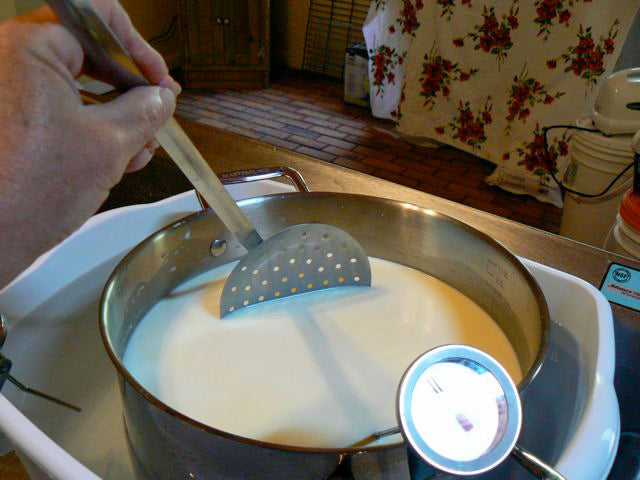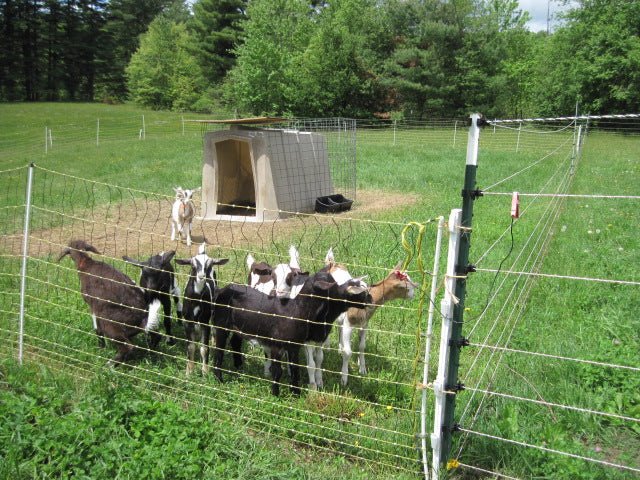 |
| Granny T. with Charlotte |
Creating a good life in Butler, TennesseeWe first posted an article called Fromage Blanc with Terrie Travers two years ago when she was a fairly new cheese maker. Then, recently, she popped up on our Facebook page with fabulous pictures of her Swiss cheese.
There aren’t too many folks making Swiss, so we asked Terrie to take pictures of her process and she was happy to oblige. (As they say- if you want to get something done, ask a busy person…)
So, after a little bit of catch up info about her amazing life as a farmer and an artist, you will find her tutorial below about making Swiss.
From Terrie:
As you may remember, we are just a small farm/homestead; poor dirt farmers/starving artists. We believe you should always have fun whenever possible. We tend to be workaholics, so this is a must for us, especially in these hard economic times.
We raise plants and produce which we sell at regional and local markets and our art work is sold in various shops from the East Coast to West Coast (The Appalachian Shed). Note: Their website is under construction, but you can still see a lot of their work.
 |
| Glass piece |
 |
| Glass bowl – Exotic Mistress |
 |
| Wood – blue crabs |
 |
| Shitake mushrooms |
We really enjoy what we do; growing and creating. But, we also like to have fun with food. That’s really where the cheese making came in. There is always the component of wanting good wholesome food in a world full of “fake” food. But really, cheese making is fun!
We are also into fermenting, growing mushrooms, and oddities in the garden. This year we are giving cotton and quinoa a shot.
We do always, of course, have a huge selection of weeds. Most of them are unwanted, but some of them, like lambs quarters, are delicious stir fried up with some garlic and balsamic vinegar. There is some odd sense of revenge and satisfaction in eating your weeds.
 |
| Trinity holding garlic and a beet (henhouse in back) |
If I’m not in the studio, I prefer to be gardening or in the kitchen. When I get really stressed out from work or life, I make cheese. I kick my husband John and our furry son Hudson outside and get lost in the process. The music is often up loud and the phone goes unheard.
The “boys” usually come begging at the back door around noon for a loaf of bread and the peanut butter knowing that’s all they are going to get. They don’t complain because both of them get to reap the rewards of my cheese making.
Hudson gets any failures plus the rinds off most cheeses(he is still enjoying a 5 lb. smoked gouda that went to late acid), and John devours everything else once it hits the kitchen fridge. His favorite is Asiago Pressato. I just scaled down Jim Wallace’s recipe to a two gallon cheese. So good!
 |
| Terrie’s husband, John and Hudson |
Another of his favorites is the Caciocavallo. I add hot peppers and herbs. I have hung it in the kitchen in the winter months, but not sure how to deal with it now that it is warmer.
We love the fromage blanc as it is so easy and versatile. Currently in my “cave:” two Traditional Swiss, one Gruyere, one Asiago Pressato, half of a Honey Rubbed Montasio, two Traditional Cheddars, and one Parmesan.
 |
| Terrie’s Gruyere |
Just about all of my cheeses are made from Ricki’s book, which I find very easy to follow. For my Traditional Swiss I used raw whole milk. Those Jersey cows really give up some cream so I took a good bit of it off and replaced it with milk before starting. I added some of Ricki’s sour cream culture to that extra cream and put it in my old yogurt maker. Yummy stuff.
 |
| Making sour cream in her 1910 (exaggeration) yogurt maker |
 |
| Bottles of cream for making sour cream |
I also made some ricotta from the whey. Not a bad haul for about two and a half gallons of milk! I haven’t had a failure in a while now. The last ones were due to a faulty thermometer. I kept checking my notes and could not figure out where I went wrong?
I now keep a third (digital) thermometer around to test my cheese making thermometers before starting. I highly recommend this for new cheese makers. You get so “into” what you are doing that you overlook the simple stuff.
The waiting is the hard part. Visions of sinking my teeth into fresh,flavor packed, wholesome cheeses drive me wild while the aging takes place.
Just the same, I resist temptation and let my cheeses come into their fullness of flavor. And let me tell you, it is so worth the agonyof waiting! I especially love to see the look on others faces when they bite in.
We both enjoy growing stuff and have quite a collection of “nerdy” plants/trees on the property. Last year we harvested three of the best tasting pineapples from pots on the back deck! Tropical fruit at 2700 feet– who would have thought.
Although we lost all but the blueberries and blackberries this year to a late freeze, we have tons of fruit selections on the property. Sweet cherries, sour cherries, hardy kiwi,plums, plum-cots, apricots, grapes, apples, pears, and oriental persimmons. Going to miss the fresh fruit and juice this winter, but you just can’t let stuff like this get you down.
 |
| Trinity, holding Scruffy, is learning the part of a Horizontal Top Bar Hive. |
 |
| Terrie’s youngest son and his wife’s first child |
When life gives us lumps, we usually just talk about our smiles. That is our granddaughters Trinity (aka Sweet Pea) and Charlotte (aka Lil Chick-a-pea). Trinity comes to spend part of her summer with us every year at which time John and I revert back to childhood for unlimited giggles and laughs. We are anxiously waiting for Charlotte to grow old enough to follow the tradition.
Little Miss Charlotte was just born this March, but I can already see her chasing ducks and chickens around the place. For now I will have to be content with the few trips I manage to steal away to Knoxville to visit her (she is such a HUG-A-MUFFIN). Who would have ever thought that being a grandparent was so much fun! Amazing how much younger grands make you feel!
 |
| Logan rules the garden |
Our current family here on the Homestead:
Myself and husband John, Hudson, our 14 year old Pyrenees-Husky mix; two cats, Logan and Scruffy; one rooster (Blue) and eight hens (Lucy, Butternut, Buttercup, Jentwo, Daisy, Hope, Black Betty, and Maude); and recently acquired 10 Indian Runner ducks (yet to be named) and a pair of Embden goslings who we named Hansel and Gretel.
You never know what might strike our fancy from one day to the next, but one thing is for sure; as long as we are able, we will find a way to have fun!
Making Swiss by Terrie Travers
Recipe from Home Cheese Making, p. 122
Start in the morning so the 12 hour cycles come at the right times (when you’re not sound asleep)
Sterilize tools and cheese pot
Keep a detailed log
Bring milk to 90F
Take 1/4 cup milk out, add one packet of C201 thermophilic starter to pot
Add 1/8 tsp. Propionic Shermanii to the 1/4 cup of milk and pour into the pot
Stir well and let rest for 10 minutes
With the temp at 90F ( mine got to 92F- not a problem), add 1/2 tsp rennet diluted in 1/4 cup of cool water
Stir in an up and down motion, and then top stir if using raw milk
Cover and let rest for 30 minutes
Cut the curds with a knife and then a modified whisk to 1/4″ size
Keep the temp at 90F and gently stir for 40 minutes (foreworking)
Heat the curds by one degree every minute until the temp is 120F (about 30 minutes)
Maintain that temp for 30 minutes stirring occasionally
While waiting, sterilize mold and cloth
 |
| A basket mold on the bottom aids in filling a bottomless mold |
Test for proper break
Pour off the whey (I prefer to scoop it out) and place the curds in a cloth lined mold
 |
| Terrie scoops it out of the pot, then transfers it to the mold (easier than tipping large pot) |
Press at 8 – 10 pounds of pressure for 15 minutes
 |
| A brick wrapped in aluminum foil weighs around 8 pounds |
Remove from mold, redress the cheese and press at 14 pounds for 30 minutes
 |
| Use fresh cheesecloth for each flip |
Repeat and press at the same (14 lb.) for 2 hours
Repeat but press at 15 pounds for 12 hours
Remove from mold and cloth and put in a saturation brine soak for 12 hours
Remove from brine and pat dry, set in 50 -55F cave
Turn daily for one week, wiping clean with cloth dampened in salt water (don’t wet the cheese)
After one week, place the cheese in a warm place (68 – 74F)
Turn daily and wipe clean with cloth dampened in salt water
Let it set this way for 2 – 3 weeks while the “eyes” form, the cheese will swell and the shape changes
 |
| Before swelling (at right), after swelling at left |
Now age at 45 – 50F & 80% humidity for at least 3 months (this is the hard part)
Reddish coloration on the surface is normal, don’t try to remove it.
 |
| Terrie’s “cave” |
Making Ricotta From the Whey
I always make the whey ricotta when making hard cheese. Also, I keep a
half gallon of the whey (after making ricotta) in the fridge for cooking
and baking. By the way, the recipe for English Muffin Bread with Whey in Ricki’s
book (Home Cheese Making) is out of this world!
 |
| Heating the whey |
 |
| Scooping out Ricotta |
 |
| Ricotta drained and ready to eat |





























































































































































